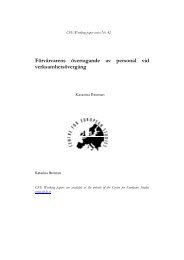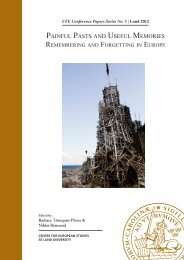MINNE OCH MANIPULATION - Centre for European Studies - Lunds ...
MINNE OCH MANIPULATION - Centre for European Studies - Lunds ...
MINNE OCH MANIPULATION - Centre for European Studies - Lunds ...
Create successful ePaper yourself
Turn your PDF publications into a flip-book with our unique Google optimized e-Paper software.
the mass consciousness. Even the attempts <strong>for</strong> relatively modest changes in the<br />
terminology and assessment of the period are either rejected, or are immediately<br />
misused <strong>for</strong> campaigns aiming to “defend Bulgarians and the Fatherland”. Despite<br />
the significant achievements of modern Bulgarian historiography, the canon of<br />
self-victimization and hero-making is constantly reiterated (Ivanova 2009). Few<br />
attempts have been made to infuse the National Narrative with the new<br />
achievements of the historiography of the Ottoman period. The problem remains –<br />
almost all other historical myths and contradictions can be discussed in a calm and<br />
academic manner in Bulgaria, except the Ottoman period. An artificially fueled<br />
fire against contemporary “revisionist historians” reflects a “national instinct”,<br />
which will not – again – allow academic reassessment of the period between ХVth<br />
and the ХІХth centuries.<br />
The exceptionally long-lived mythology of the “heavy Turkish yoke” has its<br />
origin mainly in common perceptions among Bulgarians about their history. The<br />
use of expressions such as “yoke” and the persistent substitution of “Ottomans” by<br />
“Turks” remain tangible evidence of one of the most difficult to solve problems in<br />
our modern historiography. One can list a number of topoi that re-produce this<br />
mythology again and again, most significant of them being the expression “the<br />
<strong>for</strong>ceful Islamization of the Bulgarian population. “<br />
Bulgaria belongs to the countries where a comparatively large number of<br />
people were converted to Islam. The converted population, called Bulgarian<br />
Muslims, or Pomaks, lives in a compact geographical area in the Rhodopes<br />
Mountains. During the period 1913-1989 Bulgarian Muslims have survived by<br />
changing their names from Turkish ones to Bulgarian ones and vise versa four<br />
consecutive times! The topic of the violent character of the conversion process<br />
was strongly politicized and exploited many times to serve political and state<br />
interests.<br />
Let us look into the sources that have given birth to the story of “the <strong>for</strong>ceful<br />
Islamization of Bulgarians” in the Rhodopes Mountain area. The sources are<br />
relatively few and comprise marginal notes made in Old-Bulgarian manuscripts<br />
(pripiski), all of them made public after 1870 or later, that is, almost two centuries<br />
after the occurrence of the events they describe in detail. The most significant<br />
among these sources is the narrative of priest Methody Draginov from the village<br />
of Korova, situated in the Chepino River valley (the location of the present town<br />
of Velingrad). The narrative was “discovered” and published in the famous<br />
“Geographical, Historic and Statistical Description of Tartar-Pazardjik Kaaza”<br />
printed in Vienna in 1870 by Stefan Zachariev, a Bulgarian intellectual and patriot<br />
born in Pazardjik. Priest Methody’s text describes in detail the horrible violence of<br />
the Ottomans during the Islamization of the population in the villages in the<br />
Chepino River valley. Later, two different versions of the narrative were found:<br />
“The Chronicles of St. Peter’s Monastery in Pazardjik” and “The Belovo<br />
Chronicles”. In 1879 story by Lamanski’s entitled “The Second Destruction of<br />
97




